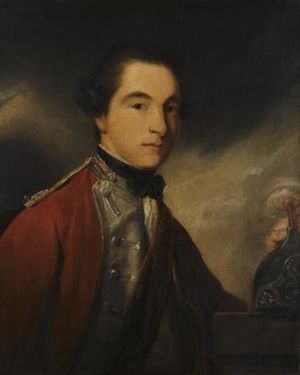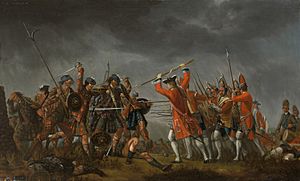Charles Moore, 1st Marquess of Drogheda facts for kids
Quick facts for kids
The Marquess of Drogheda
|
|
|---|---|

Charles Moore, 1st Marquess of Drogheda
|
|
| Born | 29 June 1730 |
| Died | 22 December 1822 (aged 92) Dublin, Ireland |
| Buried | |
| Allegiance | |
| Service/ |
|
| Years of service | 1744–1797 |
| Rank | Field Marshal |
| Battles/wars | Jacobite risings Campaign against the Whiteboys |
| Awards | Knight of the Order of St Patrick |
Charles Moore, 1st Marquess of Drogheda (born 29 June 1730 – died 22 December 1822) was an important Irish and British military leader and politician. He started his army career at a young age. He was known for carrying his regiment's flag during the Battle of Culloden in 1746. This battle was part of the Jacobite risings, a series of attempts to bring the Stuart family back to the throne.
Later, he led the 18th Light Dragoons against a group called the Whiteboys in Ireland. The Whiteboys were a secret society that protested against landlords and high rents. Charles Moore also served in the Irish House of Commons, which was like the parliament for Ireland at the time. He even became the Chief Secretary for Ireland, a very important government role.
Contents
Military and Political Career
Charles Moore joined the army in 1744 when he was just 14 years old. He started as a cornet in the 12th Dragoons. A cornet was a junior officer who carried the regiment's flag. He bravely carried this flag at the Battle of Culloden in April 1746. This battle was a major event in British history.
He quickly moved up the ranks. By 1750, he was a captain. In 1752, he became a major. He was promoted to lieutenant-colonel in 1755.
Early Political Roles
In 1757, Moore became a Member of Parliament for St Canice in the Irish Parliament. He held this seat until 1758. That year, his father passed away, and Charles Moore became the 6th Earl of Drogheda. He also became the Grandmaster of the Grand Lodge of Ireland, a leadership role in a well-known organization.
In 1759, he was made Governor of County Meath. He also became the leader of the 19th Light Dragoons, which later became the 18th Light Dragoons.
Leading the Dragoons
Charles Moore was promoted to colonel in 1762. He then became the honorary colonel of his regiment. He led the 18th Light Dragoons in their operations against the Whiteboys in Ireland, which began in 1762.
He continued to take on important government roles. In 1763, he became Chief Secretary for Ireland. This role involved helping the Lord Lieutenant of Ireland manage the country. He was also appointed a Lord Justice of Ireland in 1766.
Moore had a country home built, called Moore Abbey, in 1767. He was also given lifetime appointments as Custos Rotulorum of King's County in 1766 and Custos Rotulorum of Queen's County in 1769. These roles involved keeping public records.
Later Promotions and Honors
In 1770, Moore was promoted to major-general. He also became the Master-General of the Irish Ordnance. This meant he was in charge of military supplies and weapons in Ireland. He also led the Royal Irish Artillery.
He became a Member of Parliament for Horsham in 1776. In 1777, he was promoted to lieutenant-general. A great honor came in 1783 when he was made one of the first Knights of the Order of St. Patrick. This is a very special award in Ireland.

In 1791, he was given the title Marquess of Drogheda in the Peerage of Ireland. This was to thank him for his support of the government. He was promoted to full general in 1793. In 1797, he became one of the joint Postmasters General of Ireland, in charge of the postal service.
In 1801, he was given another title, Baron Moore, in the Peerage of the United Kingdom. This meant he could sit in the British Parliament.
Charles Moore was promoted to field marshal on 17 July 1821, when he was 91 years old. This is the highest rank in the British Army. He was also a supporter of the artist William Ashford. He passed away in Dublin on 22 December 1822 and was buried in Drogheda.
Family Life
Charles Moore married Lady Anne Seymour-Conway on 15 February 1766. She was the daughter of the 1st Marquess of Hertford. They had eight children together. Their children included Charles Moore, 2nd Marquess of Drogheda and Henry, who was the father of the 3rd Marquess. Their daughter Frances married John Vandeleur. Another daughter, Elizabeth, became the Countess of Westmeath.


